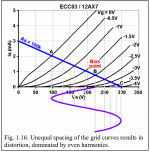Well, whether we agree with Merlin or not, if you draw a loadline for a 100k Rp and 300 V B+ on a set of 12AX7 curves, there is no arguing the fact that the thing won't saturate below 100 volts - or that twiddling bias for maximum unclipped output headroom puts the anode voltage somewhere in the general vicinity of 200 - 225 volts (and not B+/2, which is 150 volts.)
The attached image is from Blencowe's book.
-Gnobuddy
The attached image is from Blencowe's book.
-Gnobuddy
Attachments
Using a 12AX7 that way might work for small signals.
But with quiescent plate at 225V:
225V - 90V = 135V
300V - 225V = 75V
135/75 = 1.8:1 almost a 2:1 difference
As the book says, that is Lots of even harmonics.
Probably good for a Guitar, but not for Hi Fi?
But with quiescent plate at 225V:
225V - 90V = 135V
300V - 225V = 75V
135/75 = 1.8:1 almost a 2:1 difference
As the book says, that is Lots of even harmonics.
Probably good for a Guitar, but not for Hi Fi?
Last edited:
Absolutely, yes, this is intended for use with electric guitar. Not valve Hi-Fi.Probably good for a Guitar, but not for Hi Fi?
To be honest, I don't at all understand the point of valve Hi-Fi this side of, say, 1980, by which time transistor amps were doing a vastly better job of accurately reproducing an audio signal (which is the goal of Hi-Fi.)
From my point of view, what valves do best, is distort guitar signals in a way that - by pure coincidence - enhances the overall sound of an otherwise lacklustre instrument. Which happens to be the only musical instrument I have any competency with. 🙂
In other words, we electric guitarists fiddle with valves, because we envy the rich timbre of traditional instruments like cellos and saxophones, which is is sadly quite lacking in solid-body electric guitars. Freudian compensation at its best... 😀
-Gnobuddy
- Status
- Not open for further replies.
